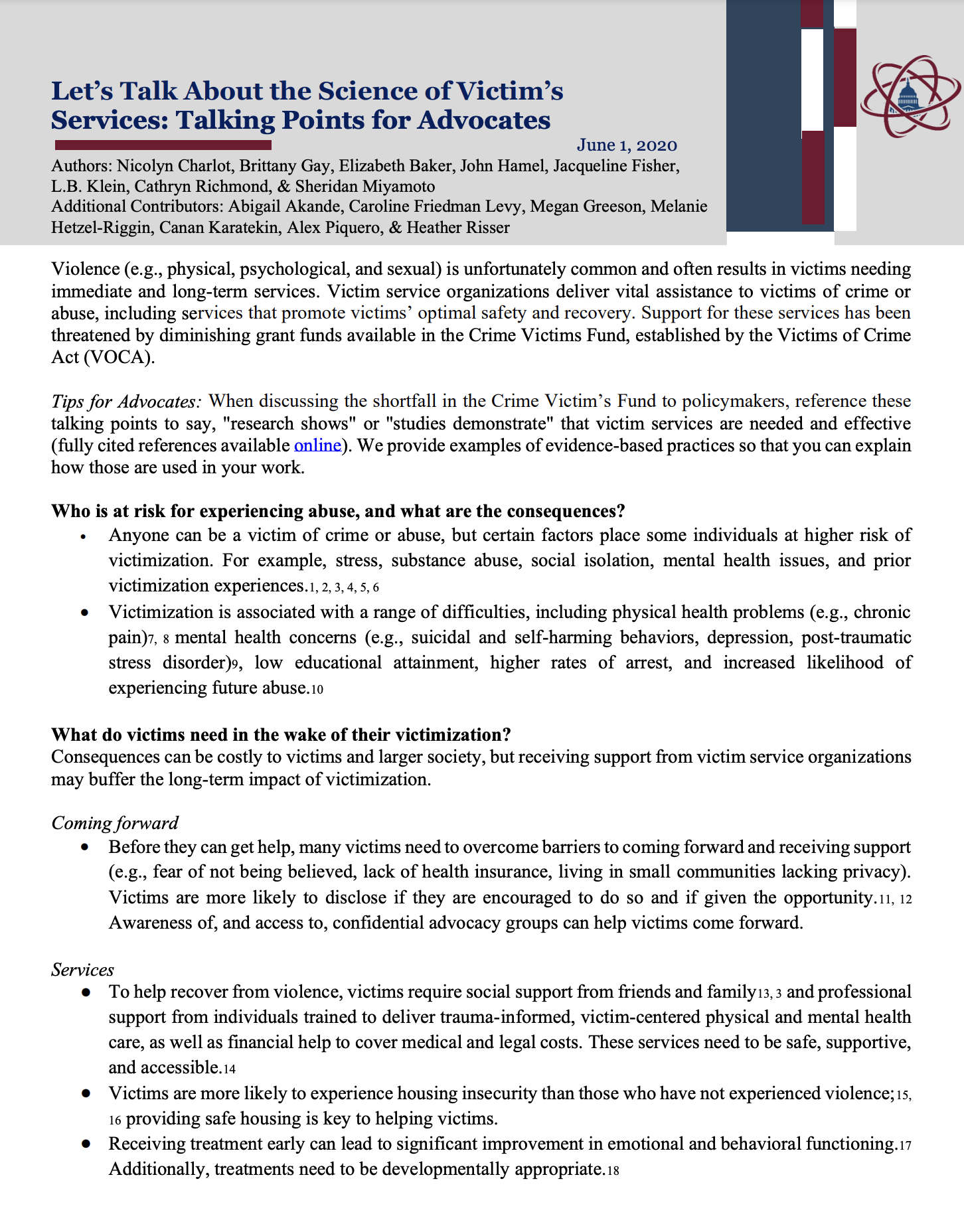
Violence (e.g., physical, psychological, and sexual) is unfortunately common and often results in victims needing immediate and long-term services. Victim service organizations deliver vital assistance to victims of crime or abuse, including services that promote victims’ optimal safety and recovery. Support for these services has been threatened by diminishing grant funds available in the Crime Victims Fund, established by the Victims of Crime Act (VOCA).
Tips for Advocates: When discussing the shortfall in the Crime Victim’s Fund to policymakers, reference these talking points to say, “research shows” or “studies demonstrate” that victim services are needed and effective (fully cited references available online). We provide examples of evidence-based practices so that you can explain how those are used in your work.
Who Is At Risk For Experiencing Abuse, And What Are The Consequences?
- Anyone can be a victim of crime or abuse, but certain factors place some individuals at higher risk of victimization. For example, stress, substance abuse, social isolation, mental health issues, and prior victimization experiences.[i],[ii],[iii],[iv],[v],[vi]
- Victimization is associated with a range of difficulties, including physical health problems (e.g., chronic pain) [vii],[viii] mental health concerns (e.g., suicidal and self-harming behaviors, depression, post-traumatic stress disorder) [ix], low educational attainment, higher rates of arrest, and increased likelihood of experiencing future abuse.[x]
What Do Victims Need In The Wake Of Their Victimization?
Consequences can be costly to victims and larger society, but receiving support from victim service organizations may buffer the long-term impact of victimization.
Coming forward
- Before they can get help, many victims need to overcome barriers to coming forward and receiving support (e.g., fear of not being believed, lack of health insurance, living in small communities lacking privacy). Victims are more likely to disclose if they are encouraged to do so and if given the opportunity.[xi],[xii] Awareness of, and access to, confidential advocacy groups can help victims come forward.
Services
- To help recover from violence, victims require social support from friends and family [xiii],[iii] and professional support from individuals trained to deliver trauma-informed, victim-centered physical and mental health care, as well as financial help to cover medical and legal costs. These services need to be safe, supportive, and accessible.[xiv]
- Victims are more likely to experience housing insecurity than those who have not experienced violence;[xv],[xvi] providing safe housing is key to helping victims.
- Receiving treatment early can lead to significant improvement in emotional and behavioral functioning.[xvii] Additionally, treatments need to be developmentally appropriate.[xviii]
- Having a safety plan can help victims stay safe during and after violent incidents.[xix]
What Are Evidence-based Practices For Victim Service Organizations?
Many organizations that use evidence-based practices are reliant on VOCA funds, including victim-centered advocacy groups, emergency shelters, and mental and physical health service providers.[xx] Researchers found the following practices effective for supporting victims.
- Cognitive Behavioral Therapy (CBT) can be effective at helping victims (e.g., with safety, substance use, mental health), particularly when tailored to victims’ needs.[xxi, xxii, xxiii]
- Rapid rehousing and flexible funding programs are promising.[xxiv] These programs assist victims by helping them find permanent housing or giving them financial support to prevent homelessness.
- Co-location service models (e.g., integrating child protection and domestic violence services) can improve outcomes for victims of violence (e.g., reduction in maltreatment rates and out-of-home placements, improved family functioning and stability), and improve service coordination.[xxv]
- Sexual Assault Nurse Examiners (SANE) collect forensic evidence, resulting in higher rates of successful prosecution of perpetrators.[xxvi] These services improve physical and mental health outcomes for victims of sexual assault.[xxvii]
Additionally, research suggests victim services organizations may be most helpful when they:
- Tailor their services to individuals based on diverse identities and at-risk backgrounds (e.g., victims of color,[iii],[xxviii] migrants,[xxix] gender minorities,[xxx] LGBTQ+ individuals[xxxi]).
- Incorporate victims’ input in service planning, delivery, and evaluation to narrow service gaps. This could include establishing advisory boards, hiring peer support specialists, creating tenant groups, and organizing policy advocacy initiatives.[xxxii]
In summary, research demonstrates victim service organizations are crucial for addressing multiple forms of violence and exploitation. Currently, Crime Victim Funds are one of the few or only sources of funding for effective victim service coordination across states, territories, and tribal lands. These funds are rapidly depleting. We urge policymakers to act and support victim service organizations so they can continue providing essential support to those in need.
The Research-to-Policy Collaboration (RPC) works to bring together research professionals and public officials to support evidence-based policy. Please visit their website to learn more.
Key Information
RPC Website
Research-to-Policy Collaboration
More RPC Resources
RPC Resources
Publication DateJune 1, 2020
Topic Area(s)Community-Specific, Health, Violence and Victimization
Resource TypeWritten Briefs
Share This Page
Violence (e.g., physical, psychological, and sexual) is unfortunately common and often results in victims needing immediate and long-term services. Victim service organizations deliver vital assistance to victims of crime or abuse, including services that promote victims’ optimal safety and recovery. Support for these services has been threatened by diminishing grant funds available in the Crime Victims Fund, established by the Victims of Crime Act (VOCA).
Tips for Advocates: When discussing the shortfall in the Crime Victim’s Fund to policymakers, reference these talking points to say, “research shows” or “studies demonstrate” that victim services are needed and effective (fully cited references available online). We provide examples of evidence-based practices so that you can explain how those are used in your work.
Who Is At Risk For Experiencing Abuse, And What Are The Consequences?
- Anyone can be a victim of crime or abuse, but certain factors place some individuals at higher risk of victimization. For example, stress, substance abuse, social isolation, mental health issues, and prior victimization experiences.[i],[ii],[iii],[iv],[v],[vi]
- Victimization is associated with a range of difficulties, including physical health problems (e.g., chronic pain) [vii],[viii] mental health concerns (e.g., suicidal and self-harming behaviors, depression, post-traumatic stress disorder) [ix], low educational attainment, higher rates of arrest, and increased likelihood of experiencing future abuse.[x]
What Do Victims Need In The Wake Of Their Victimization?
Consequences can be costly to victims and larger society, but receiving support from victim service organizations may buffer the long-term impact of victimization.
Coming forward
- Before they can get help, many victims need to overcome barriers to coming forward and receiving support (e.g., fear of not being believed, lack of health insurance, living in small communities lacking privacy). Victims are more likely to disclose if they are encouraged to do so and if given the opportunity.[xi],[xii] Awareness of, and access to, confidential advocacy groups can help victims come forward.
Services
- To help recover from violence, victims require social support from friends and family [xiii],[iii] and professional support from individuals trained to deliver trauma-informed, victim-centered physical and mental health care, as well as financial help to cover medical and legal costs. These services need to be safe, supportive, and accessible.[xiv]
- Victims are more likely to experience housing insecurity than those who have not experienced violence;[xv],[xvi] providing safe housing is key to helping victims.
- Receiving treatment early can lead to significant improvement in emotional and behavioral functioning.[xvii] Additionally, treatments need to be developmentally appropriate.[xviii]
- Having a safety plan can help victims stay safe during and after violent incidents.[xix]
What Are Evidence-based Practices For Victim Service Organizations?
Many organizations that use evidence-based practices are reliant on VOCA funds, including victim-centered advocacy groups, emergency shelters, and mental and physical health service providers.[xx] Researchers found the following practices effective for supporting victims.
- Cognitive Behavioral Therapy (CBT) can be effective at helping victims (e.g., with safety, substance use, mental health), particularly when tailored to victims’ needs.[xxi, xxii, xxiii]
- Rapid rehousing and flexible funding programs are promising.[xxiv] These programs assist victims by helping them find permanent housing or giving them financial support to prevent homelessness.
- Co-location service models (e.g., integrating child protection and domestic violence services) can improve outcomes for victims of violence (e.g., reduction in maltreatment rates and out-of-home placements, improved family functioning and stability), and improve service coordination.[xxv]
- Sexual Assault Nurse Examiners (SANE) collect forensic evidence, resulting in higher rates of successful prosecution of perpetrators.[xxvi] These services improve physical and mental health outcomes for victims of sexual assault.[xxvii]
Additionally, research suggests victim services organizations may be most helpful when they:
- Tailor their services to individuals based on diverse identities and at-risk backgrounds (e.g., victims of color,[iii],[xxviii] migrants,[xxix] gender minorities,[xxx] LGBTQ+ individuals[xxxi]).
- Incorporate victims’ input in service planning, delivery, and evaluation to narrow service gaps. This could include establishing advisory boards, hiring peer support specialists, creating tenant groups, and organizing policy advocacy initiatives.[xxxii]
In summary, research demonstrates victim service organizations are crucial for addressing multiple forms of violence and exploitation. Currently, Crime Victim Funds are one of the few or only sources of funding for effective victim service coordination across states, territories, and tribal lands. These funds are rapidly depleting. We urge policymakers to act and support victim service organizations so they can continue providing essential support to those in need.
The Research-to-Policy Collaboration (RPC) works to bring together research professionals and public officials to support evidence-based policy. Please visit their website to learn more.

Key Information
RPC Website
Research-to-Policy Collaboration
More RPC Resources
RPC Resources
Publication DateJune 1, 2020
Topic Area(s)Community-Specific, Health, Violence and Victimization
Resource TypeWritten Briefs
Share This Page
LET’S STAY IN TOUCH
Join the Evidence-to-Impact Mailing List
Keep up to date with the latest resources, events, and news from the EIC.




